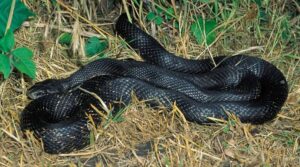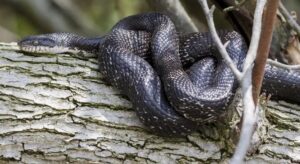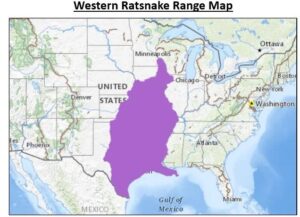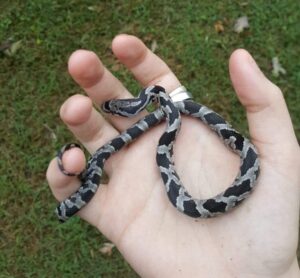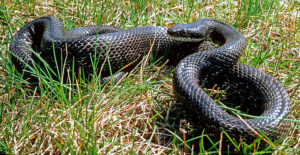The western rat snake is a colubrid native to central North America. It is also known by the names pilot black snake, black rat snake, or simply black snake. The snake is active during the day. It has one of the largest ranges among all the common rat snakes.
Scientific Classifications
- Suborder:Serpentes
- Family:Colubridae
- Genus:Pantherophis
- Species:P. obsoletus
Conservation Status
Subspecies
This snake has no recognized subspecies. A color variation is given below.
- Texas rat snake (Pantherophis obsoletus lindheimeri)
Description
Size
The adults can get quite large, with their typical total length (including their tail) being 3ft 6 in – 6ft (106.5–183 cm). With a record total length of 8ft 5 in (256.5 cm), it is officially the biggest snake in North America. An adult’s body mass is 1.1-4.9 lb (0.5-2.2 kg) though most are on the smaller end of this range, with weights commonly being between 1.7-2.2 lb (0.77-1 kg).
Color and Appearance
The juveniles are strongly patterned with brown blotches against a gray background. They rapidly become dark as they grow. The adults are glossy black on the dorsal side with white lips, throat, and chin. Sometimes the disappeared juvenile pattern is still visible in the skin between the scales, especially when it is stretched after a heavy meal.
Are They Dangerous to Humans
When started, the western ratsnake may freeze and wrinkle itself into a series of kinks. If it is threatened further, it may flee fast or vibrate its tail in an attempt to sound like rattlesnakes. If picked up, the snake releases a foul-smelling musk that is spread with its tail to deter its predator. When provoked or cornered, the black rat snake stands its ground and can become aggressive, leading to a bite. But it can’t cause harm as it is non-venomous.
Western Rat Snakes at a Glance
Distribution
The western rat snake can be found west of the Mississippi River, from southern and eastern Iowa southward through Arkansas and Missouri to western Louisiana, westward to eastern Texas, northward through eastern Kansas, and Oklahoma to southeastern Nebraska.
Habitat
The colubrid lives in a variety of habitats, some overlapping each other. These include prairie, bayou, and rock outcrops, but they prefer wooded places, especially oak trees.
The excellent climbers spend a significant amount of their time on trees. They are also good swimmers. Winter sees them hibernate in shared dens, often with timber rattlesnakes and copperheads. This is what led to its common name, the pilot black snake, as it is thought that it showed the venomous species the way to its den.
Lifespan
The species can live up to 15 years in captivity or even more with proper care. The average lifespan in the wild is 10-15 years.
Predators
It is preyed upon by mammalian carnivores (including the American mink that weighs no more than the adult snake) and big birds of prey, especially the red-tailed hawk. The babies become the food of many animals, including other snakes.
Big snakes, longer than 59 in (150 cm), can commit counter-attacks on large birds of prey, resulting in prolonged, violent struggles. The black snake uses its infamous agility and formidable strength of its muscular coils to overwhelm and kill its avian predators like great-horned owls, red-tailed hawks, and red-shouldered hawks. However, in many cases, the bird is able to kill the snake, and both of them may even die.
Diet
The constrictor often eats voles, mice, and rats, but it will readily feed on any small vertebrate it can catch. It can opportunistically consume frogs, moles, lizards, squirrels, chipmunks, juvenile opossums, juvenile rabbits, other snakes (both of the same and other species), songbirds, and bird eggs.
One pilot black snake was seen to eat an entire clutch of mallard eggs. Preferring cavity-nesting birds, the snake is the top predator of purple martin colonies, with a single big snake devouring a number of eggs, adults, and hatchlings every summer.
Reproduction
Oviparous (lays eggs that hatch outside the body)
Mating occurs in late May and early June when the male wraps its tail around the female so that their vents nearly touch. He then everts one of his sex organs, the hemipenis, into her sex organ, the cloaca. The union lasts for a few minutes to a few hours. After a few weeks, she lays 12-20 eggs which are 1.4-2.4 in (36-60 mm) long and 0.79-1.04 in (20-26.5 mm) wide. The eggs hatch after 65-70 days, from late August to early October. The total length of the hatchlings is 11-16 in (28-41 cm), and they resemble miniature fox snakes in their looks.
Care Sheet
Size of the Enclosure: A 30-40 gallon tank is ideal for the snake.
Temperature: The enclosure’s temperature should be kept in the range of 80-85°F. It can drop to 70°F at night.
Humidity: The black snake requires moderate humidity levels of 35-60%. A water bowl large enough for the snake to nicely soak in should be provided.
Substrate: The tank should have a loose substrate, such as newspaper or aspen wood shavings.
Feeding: The pets can be fed stunned or pre-killed mice as captive-bred mice reduce the risk of injuries by live prey and exposure to pathogens. The feeding frequency is usually once a week, but it can vary depending on the size of the food and the snake.
Source
mdc.mo.gov, mnherps.com, morphmarket.com, media.kidadl.com, birdwatchinghq.com, usasnakes.com, reddit.com, render.fineartamerica.com

